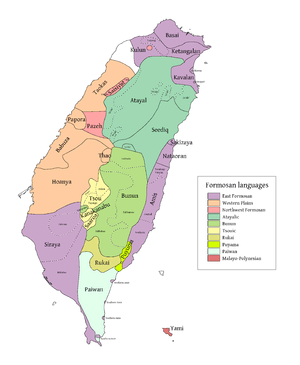Taiwanese Sign Language
| Taiwanese Sign Language | |
|---|---|
| Taiwan Ziran Shouyu | |
| Native to | Taiwan |
Native speakers | 20,000 (2004)[1] |
|
Japanese Sign
| |
| Language codes | |
| ISO 639-3 |
tss |
| Glottolog |
taiw1241[2] |
Taiwanese Sign Language or TSL (Chinese: 台灣手語; pinyin: Táiwān Shǒuyǔ) is the deaf sign language most commonly used in Taiwan.
History
The beginnings of Taiwan Sign Language date from 1895.[3]
The origins of TSL developed from Japanese Sign Language during Japanese rule. TSL is considered part of the Japanese Sign Language family.[4]
TSL has some mutual intelligibility with both Japanese Sign Language and Korean Sign Language; it has about a 60% lexical similarity with JSL.[3]
There are two main dialects of TSL centered on two of the three major sign language schools in Taiwan: one in Taipei, the other in Tainan City (the Taichung school used a sign language essentially the same as the Tainan school).
After the retrocession of Taiwan to the ROC, Taiwan absorbed an influx of Chinese Sign Language users from mainland China who influenced TSL through teaching methods and loanwords.[3]
Serious linguistic research on TSL began in the 1970s and is continuing at present. The first International Symposium on Taiwan Sign Language Linguistics was held on March 1–2, 2003, at National Chung Cheng University in Minxiong, Chiayi, Taiwan.
Functional markers
TSL, like other sign languages, incorporates non-manual markers with lexical, syntactic, discourse, and affective functions. These include brow raising and furrowing, frowning, head shaking and nodding, and leaning and shifting the torso.[5]
Notes
- ↑ Taiwanese Sign Language at Ethnologue (18th ed., 2015)
- ↑ Hammarström, Harald; Forkel, Robert; Haspelmath, Martin; Bank, Sebastian, eds. (2016). "Taiwan Sign Language". Glottolog 2.7. Jena: Max Planck Institute for the Science of Human History.
- 1 2 3 Fischer, Susan et al. (2010). "Variation in East Asian Sign Language Structures" in Sign Languages, p. 501., p. 501, at Google Books
- ↑ Fischer, p. 499., p. 499, at Google Books
- ↑ Fischer, p. 507., p. 507, at Google Books
References
- Brentari, Diane. (2010). Sign Languages. Cambridge: Cambridge University Press. ISBN 9780521883702; OCLC 428024472
- Huteson, Greg (2003). "Report on Social, Educational, and Sociolinguistic Issues that Impact the Deaf and Hard of Hearing Population of Taiwan" (PDF). SIL International.
- Shih Wen-han & Ting Li-fen, ed. (1999). Shou Neng Sheng Ch'iao Vol. I (13th ed.). Taipei: National Association of the Deaf in the Republic of China.
Further reading
- Sasaki, Daisuke. (2007). "Comparing the lexicons of Japanese Sign Language and Taiwan Sign Language: a preliminary study focusing on the difference in the handshape parameter," Sign Language in Contact: Sociolinguistics in Deaf Communities (David Quinto-Pozos, editor). Washington, D.C.: Gallaudet University Press. ISBN 9781563683565; OCLC 154789790
- Smith, Wayne H. Taiwan Sign Language research: an historical overview. Language and Linguistics (Taipei) 6.2 (2005): 187-215. Online free access
External links
- Associations
- National Association of the Deaf in the Republic of China(in traditional Chinese)
- Chinese Deaf Association, R.O.C.
- Schools
- Dictionaries
- TSL Online Dictionary (in English and Traditional Chinese)
